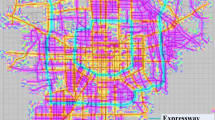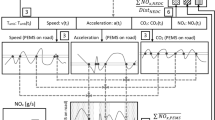Abstract
The exhaust emissions and fuel consumption rates of newly registered automobiles in Thailand are currently assessed using the standard driving cycle of the Economic Commission of Europe (ECE). Because of the highly different driving conditions, the assessment results may not reflect realistic amounts of emissions and fuel consumption for vehicles in Bangkok traffic, which is well known for its congestion. The objective of this study is therefore to develop a new driving cycle for vehicles traveling on Bangkok’s main roads during peak traffic hours. This paper first presents the development of a method for selecting representative road routes with traffic conditions that are representative of traffic in Bangkok for conducting real-world driving speed data collection. These real-world data are obtained by driving a car equipped with a speed-time data logger along those selected road routes. Several driving characteristics, including various profiles of microtrips, are analyzed from the collected speed-time data, and a number of target driving parameters are then defined for use as a set of criteria to justify the best driving cycle. A procedure for generating driving cycles from the analyzed real-driving data is also developed, and the method to select the cycle that is most representative of Bangkok traffic is described. Comparisons found in the study show that the target driving parameters of the newly developed driving cycle are much closer to those obtained from the real-world measured data than those calculated from the presently used European drive cycle. This would imply that the obtained driving cycle will produce more realistic results of the emissions and fuel consumption assessment tests for vehicles traveling in Bangkok. The methods developed in this study for route selection and driving cycle construction can easily be adopted by other big cities to develop their own vehicle driving cycles. Furthermore, although the developed methods are for passenger cars, similar approaches can be applied to develop driving cycles for other types of vehicle, such as city buses and pick-up trucks.
Similar content being viewed by others
References
André, M., Hickman, J. A., Hassel, D. and Joumard, R. (1995). Driving cycles for emission measurements under european conditions. SAE Paper No. 950926, 193–205.
Austin, T. C., Carlson, T. R. and Dulla, R. G. (1995). Methodology for Generating Driving Cycles for Inventory Development. Report No. SR95-09-02. Prepared for the U.S. Environmental Protection Agency. Sierra Research Inc. California, 66.
Booth, A. E., Muneer, T., Kirby, J., Kubie, J. and Hunter, J. (2001). The measurement of vehicular driving cycle within the city of Edinburgh. Transportation Research Part D, 6, 209–220.
Department of Land Transport: Transport Statistics Subdivision (2001). Road Transport Statistics 2000. Department of Land Transport, Ministry of Transport and Communications, Thailand, 2.
Dirks, K. N., Johns, M. D., Hay, J. E. and Sturman, A. P. (2003). A semi-empirical model for predicting the effect of changes on traffic flow patterns on carbon monoxide concentrations. Atmospheric Environment, 37, 2719–2724.
Ergeneman, M., Sorusbay, C. and Goktan, A. (1997). Development of a driving cycle for the prediction of pollutant emissions and fuel consumption. Int. J. Vehicle Design 18,3/4(Special Issue), 391–399.
Ericsson, E. (2001). Independent driving pattern factors and their influence on fuel-use and exhaust emission factors. Transportation Research Part D, 6, 325–345.
Haan, P. D. and Keller, M. (2000). Emission factors for passenger car: application of instantaneous emission modeling. Atmospheric Environment, 34, 4629–4638.
Hung, W. T., Tam, K. M., Lee, C. P., Chan, L. Y. and Cheung, C. S. (2005). Comparison of driving characteristics in cities of pearl river delta, China. Atmospheric Environment, 39, 615–625.
Leong, S. T., Muttamara, S. and Laortanakul, P. (2002). Influence of benzene emission from motorcycles on Bangkok air quality. Atmospheric Environment, 36, 651–661.
Mannering, F. L. and Kilareski, W. P. (1998). Principles of Highway Engineering and Traffic Analysis. 2nd edn. John Wiley & Sons, Inc. USA. 337.
Sa, J. S., Chung, N. H. and Sunwoo, M. H. (2003). Experimental analysis of driving patterns and fuel economy for passenger cars in Seoul. Int. J. Automotive Technology 4,2, 101–108.
Thai Industrial Standards Institute (TISI) (2003). Thai Industrial Standard (TIS 2160-2003) Gasoline Engined Vehicles: Safety Requirements; Emission from Engine, Level 7. TISI. Bangkok.
Tong, H. Y., Hung, W. T. and Cheung, C. S. (1999). Development of a driving cycle for Hong Kong. Atmospheric Environment, 33, 2323–2335.
Traffic and Transportation Department (TTD) (2000). Traffic Flow of Specific Junctions in Bangkok. TTD. Bangkok. 66.
Traffic Research Board (2000). Highway Capacity Manual: HCM 2000. National Research Council. Washington D.C., 19.
USEPA, United States Environmental Protection Agency (2006). EPA Dynamometer Driver’s Aid. http://www.epa.gov/otaq/labda.htm.
Wang, B. H., Luo, Y. G. and Zhang, J. W. (2008). Simulation of city bus performance based on actual urban driving cycle in China. Int. J. Automotive Technology 9,4, 501–507.
Watson, H. C., Milkins, E. E. and Braunsteins, J. (1982). The development of the Melbourne peak cycle. Presented to Joint SAE-A/ARRB Second Conf. Traffic, Energy and Emissions, Paper No. 82148, Melbourne, 18.1–18.21.
Wibulswas, P. (1997). Emission from transportation in Thailand. Mahidol J. 4,2, 99–120.
Wright, P. H. (1996). Highway Engineering. 6th edn. John Wiley & Sons. USA. 131–161.
Author information
Authors and Affiliations
Corresponding author
Rights and permissions
About this article
Cite this article
Tamsanya, S., Chungpaibulpatana, S. & Limmeechokchai, B. Development of a driving cycle for the measurement of fuel consumption and exhaust emissions of automobiles in Bangkok during peak periods. Int.J Automot. Technol. 10, 251–264 (2009). https://doi.org/10.1007/s12239-009-0030-4
Received:
Revised:
Published:
Issue Date:
DOI: https://doi.org/10.1007/s12239-009-0030-4




